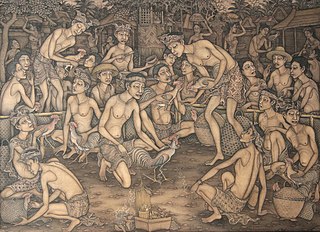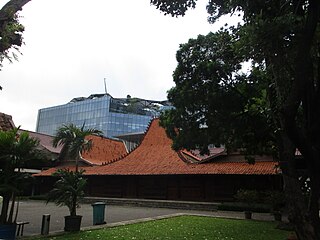
The kris, or keris in the Indonesian languages, is an Indonesian asymmetrical dagger, both weapon and spiritual object, with distinctive blade-patterning achieved through alternating laminations of iron and nickelous iron (pamor). Of Javanese origin, the kris is famous for its distinctive wavy blade, although many have straight blades as well, and is one of the weapons commonly used in the pencak silat martial art, native to Indonesia.

Ubud is a town on the Indonesian island of Bali in Ubud District, located amongst rice paddies and steep ravines in the central foothills of the Gianyar regency. Promoted as an arts and culture centre, it has developed a large tourism industry. It forms a northern part of the Greater Denpasar metropolitan area.
Adrianus Wilhelmus "Arie" Smit was a Dutch-born Indonesian painter who lived on Bali.
I Ketut Soki is a successful artist from Bali. As a boy, he was one of the first two children to receive art lessons from the famous artist Arie Smit, and so one of the founders of the "Young Artists" movement.

Balinese art is art of Hindu-Javanese origin that grew from the work of artisans of the Majapahit Kingdom, with their expansion to Bali in the late 14th century. From the sixteenth until the twentieth centuries, the village of Kamasan, Klungkung, was the centre of classical Balinese art. During the first part of the twentieth century, new varieties of Balinese art developed. Since the late twentieth century, Ubud and its neighboring villages established a reputation as the center of Balinese art.

Museum Rudana or Rudana Art Museum is an art museum in Peliatan, Gianyar Regency, Bali, Indonesia. It was built by Nyoman Rudana, following the concept of the Bali humanist philosophy of Tri Hita Karana, where art makes a contribution to public wellbeing.
Nyoman Rudana is a former member of the Regional Representatives Council of Indonesia. He is also the founder and owner of Museum Rudana, Rudana Fine Art Gallery and Genta Fine Art Gallery, and founder of artist support organizations in Ubud, Bali.

Johan Rudolf Bonnet was a Dutch artist who lived much of his life in the town of Ubud on Bali, Indonesia. He was born into a Dutch Huguenot-descended family who had been bakers for many generations. He attended the Rijksakademie van Beeldende Kunsten in Amsterdam.

Ida Bagus Made Poleng (1915–1999) was a traditional Balinese painter. Known also as Ida Bagus Made Poleng or Ida Bagus Made Tebesaya or simply Gus Made.
Anak Agung Gde Sobrat (1912–1992) was a painter in Indonesia.
I Gusti Nyoman Lempad (1862?–1978) was a Balinese stone sculptor, architect and painter who built palaces and temples in Ubud and its neighboring villages. Lempad's exact birth date, as is the case for many Balinese of his time, is unknown. But he was married when Krakatoa erupted in 1883.
Ida Bagus Nyoman Rai (~1915-2000) was a traditional Balinese painter from Sanur, a beach resort near Denpasar, Bali, Indonesia. He was also known as I Bagus Nyoman Rai Tengkeng or Ida Bagus Nyoman Rai Klingking

Batuan is a village in Bali, Indonesia. It is noted for its artwork and style of painting which originated in the village in the 1930s and has since emerged into a major Balinese artistic style, known as a Batuan painting. It is a major painting center and contains a number of art galleries and cooperative art societies which have played a key role in promoting the art of Batuan. The village is also known for its performance of the ancient Gambuh dance, performed every Full Moon day.
Gajah Gallery is an art gallery in Singapore that hosts artwork related to the socio-cultural interests of Asia. It was established in 1995 by Jasdeep Sandhu and promotes Southeast Asian Contemporary Art with an emphasis on Indonesian Contemporary. The gallery holds exhibitions, some of which have been collaborations with the Singapore Art Museum (SAM) and the National University of Singapore Museum (NUS). Gajah Gallery is also a member of Art Galleries Association in Singapore.

Bentara Budaya Jakarta is a cultural center located on Jalan Palmerah Selatan 17, Central Jakarta, Indonesia. The institution consists of a museum and an art gallery. Open from Monday to Friday at 8 AM to 5 PM, the gallery is closed on weekends and holidays, with an exception being made when special exhibitions are present. Entry to the gallery is free of charge and open to visitors.

It is quite difficult to define Indonesian art, since the country is immensely diverse. The sprawling archipelago nation consists of 17.000 islands. Around 922 of those permanently inhabited, by over 1,300 ethnic groups, which speak more than 700 living languages.

Pura Taman Saraswati, officially Pura Taman Kemuda Saraswati, also known as the Ubud Water Palace, is a Balinese Hindu temple in Ubud, Bali, Indonesia. The pura is dedicated to the goddess Sarasvati. Pura Taman Saraswati is notable for its lotus pond.














